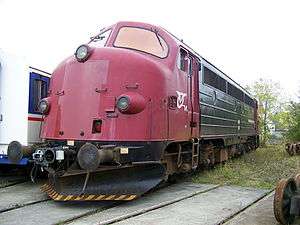DSB Class MY
|
| |||||||||||||||||||||||||||||||||||||||||||
| |||||||||||||||||||||||||||||||||||||||||||
| |||||||||||||||||||||||||||||||||||||||||||
| |||||||||||||||||||||||||||||||||||||||||||
| |||||||||||||||||||||||||||||||||||||||||||
The class MY is a class of diesel-electric locomotives built in the years 1954–65 by NOHAB. A total of 59 units, numbered 1101–1159, were delivered to the Danish State Railways. Powered by GM-EMD engines, the locomotives represented a significant change in rolling stock policy — motive power had largely been sourced from within Denmark for several decades.[4]
History
In the early 50s the DSB was starting to look for a new type of motive power that could replace steam locomotives in Denmark.
MY 1101 was built by NOHAB alone, but all subsequent units had bodies, underbodies and bogies[1] built at Danish manufacturer Frichs in order to limit foreign currency spending.[5] For the same reason, and because of pressure from Danish industry, the electrical systems of MY 1105 and later were sub-supplied by Danish companies Thrige and Titan.[6][7]
The DSB ordered the first four units which arrived at Helsingør in 1954. The locomotives quickly became very popular among both passengers and crew.
To replace steam on branch lines, a similar but lighter locomotive, the class MX, was developed, incorporating a 12-cylinder 567 engine.[8]
In their early years the locomotives hauled express trains (later known as InterCity) and heavy freight services, but in their later years they were transferred to smaller regional and light freight services.
In the 1980s and 90s the DSB began to have less and less need for them, and the last ordinary MY-hauled train ran in 2001. One unit however, 1135, is now a special service locomotive which runs special trains, so DSB still has MY locos in service. The others have either been scrapped or sold to diverse private operators in Norway, Germany and Sweden, who now use them on light freight duties. They are called TMY in Sweden (as diesel locomotives have names beginning with T in Sweden).
Many locomotives similar to the MY survive in other countries. They include:
- Norwegian State Railways Class Di 3
- Hungarian State Railways Class M61
- Chemins de fer luxembourgeois Class 1600
- National Railway Company of Belgium Class 52–54
Technical details
The first four units, 1101–1104, were delivered with 1,700-hp EMD 567B engines along with a spare engine. Having a spare engine was later deemed unnecessary and the fifth 567B engine was thus built into MY 1105.[7] 1106–1144 were delivered with 1,950-hp EMD 567C engines. MY 1145–1159 were delivered with 1,950-hp EMD 567D1 engines.[9] Starting in 1968, the weaker MYs with 567B engines were reclassified as class MV, with the classification following the 567B engines as they were swapped around among the locomotives during maintenance.[10][11] MY 1149 received a spare 645E engine (as used in class MZ, though with the turbocharger removed) after sustaining severe frost damage in the harsh winter of 1978–79.[1]
Livery
The locomotives were delivered in DSB's then-standard maroon colour, with horizontal white stripes along the mid and bottom of the sides and a yellow winged wheel at each front. Starting in 1965, the DIN 1451 typeface was slowly introduced for the lettering, and a few locomotives were given an "economy" maroon livery without stripes during the 1970s.[12]
A new design with black sides and red cabs was introduced by DSB in 1972. The first class MY unit to receive the new livery was MY 1147 in 1972, with the remaining locomotives repainted between 1975 and 1985.[13][12]
Preservation
A handful of the MY locomotives have been preserved, several in working order. MY 1101, in original maroon livery,[14] and 1159, in red/black,[15] are both preserved in running order by DSB Museumstog. MY 1112, having one side cut open, and one cab of 1129,[16] are on exhibition in the Danish Railway Museum. MY 1104 was preserved for a number of years by GM-Gruppen in Norway, but is now in the railway museum in Struer.[17][18] 1126, in special decorative livery, is under the care of Jysk Veterantog for the Danish Railway Club (DJK).[19] MY 1138 was transferred to Germany in 1999 and is still in working order, mostly used as a backup locomotive for freight trains. [20]
See also
References
Notes
- 1 2 3 4 5 6 7 8 9 Andersen 1998, pp. 64–69.
- ↑ Christensen & Poulsen 1999, pp. 110–114.
- ↑ Løvborg & Mogensen 2000, p. 10.
- ↑ Christensen & Poulsen 1999, p. 3.
- ↑ Christensen & Poulsen 1999, p. 19.
- ↑ Andersen 1998, p. 14.
- 1 2 Christensen & Poulsen 1999, p. 27.
- ↑ Christensen & Poulsen 1999, pp. 34–35.
- ↑ Christensen & Poulsen 1999, p. 46.
- ↑ Andersen 1998, p. 48.
- ↑ Christensen & Poulsen 1999, p. 55.
- 1 2 Andersen 1998, pp. 61–62.
- ↑ Andersen 1998, pp. 50–51.
- ↑ "My 1101" (in Danish). DSB Museumstog. Retrieved 2009-02-16.
- ↑ "My 1159" (in Danish). DSB Museumstog. Retrieved 2009-02-16.
- ↑ Støvring-Nielsen, Allan (October 2002). "MY 1129 — et lokomotiv og dets pudsige skæbne". Jernbanen (in Danish). Dansk Jernbane-Klub: 24–25. ISSN 0107-3702. Archived from the original on 2011-07-19. Retrieved 2009-02-16.
- ↑ "DSB MY 1104". Jernbanen.dk (in Danish). Retrieved 2016-01-12.
- ↑ "Struer Jernbanemuseum" (in Danish). DR. Retrieved 2009-02-16.
- ↑ "DSB MY 1126" (in Danish). Jysk Veterantog. Archived from the original on 2008-09-25. Retrieved 2009-02-16.
- ↑ "DSB MY 1138" (in German). Retrieved 2012-09-07.
Bibliography
- Andersen, Torben (1998). DSB litra MY, type 567. Lokomotivets Forlag. ISBN 87-90779-00-2.
- Christensen, Peter; Poulsen, John (1999). Motor Materiel 5: Med motor fra GM (in Danish). Bane Bøger. ISBN 87-88632-79-2.
- Løvborg, Eilert; Mogensen, Peter, eds. (2000). DSB materiel i drift (in Danish) (2nd ed.). DSB drift. ISBN 87-7025-011-1.
External links
| Wikimedia Commons has media related to DSB MY. |
- jernbanen.dk
- GM-nyt.dk
- Roundnoses.com
- Nohab-GM.de (German)
